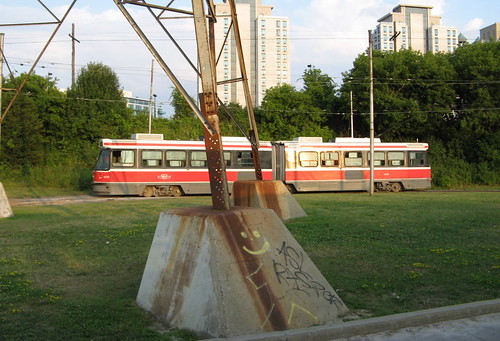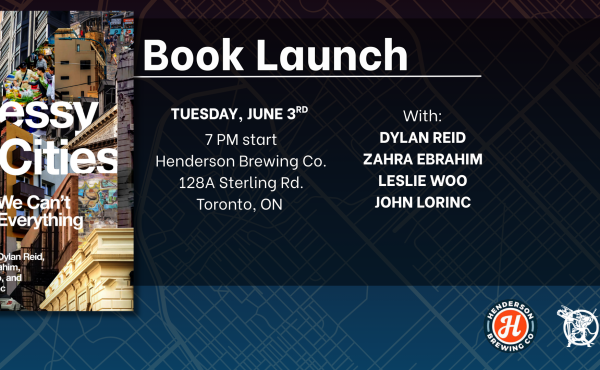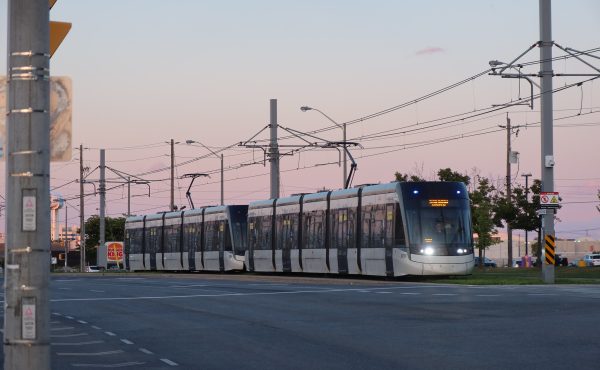
The 501 Queen Streetcar was recently named by National Geographic as one of the ten great tram rides of a lifetime (up there with the San Francisco F-Market Car, the Hong Kong double-decked trams, and the New Orleans streetcars), and it is certainly an interesting and fun ride if you’re not in a hurry. Unfortunately, it may actually feel like a lifetime to complete a round trip of this great transit ride of an interesting street given the route’s delays and frequent short-turns.
Queen has long been a busy and slow street, but the problems became worse over the past 15 years. In 1995, the former 507 Long Branch streetcar, which operated exclusively in Etobicoke and a legacy of the old radial railway network to Toronto’s suburbs, was discontinued and joined with the 501, making it by far the longest streetcar route in the city. End to end, the route is 24 kilometres long between Long Branch at the Mississauga border and Neville Park Avenue. Additionally, service cuts due to provincial funding cutbacks reduced service on most surface routes, to the extent that it allowed the TTC to dispose of its historic PCC fleet even while increasing route mileage with new routes on Spadina and Queen’s Quay in 1997 and 2000.
While traffic, particuarly on Queen West, has served to delay streetcars, the bigger problem is the TTC’s insistance on short-turns, leaving passengers stranded at in front of the old Greenwood Race Track, at Roncesvalles and Queen, or at desolate Humber Loop. Also, even with inconvenient short-turns, streetcars tend to bunch, even at the far ends of the route, leaving long waits between the convoys, especially in the Beach(es) and in Etobicoke.
After the Fix the 501 Forum, the TTC changed the operation of the Queen Car from a schedule-based system, trying to adhere to specific times to a headway-based system, based on maintaining a minimum distance between cars. This change is supposed to allow for more even service by spacing streetcars out and reducing the incidence of short-turns that have plagued both the eastern and western extremes of the route.
But citizens in the east end have reported that they found service still lacking, even though is now a bit more reliable. The bottom line is that the service is still not at a level where Beach(es) residents can depend on it.
In response to the forum and pressure from citizens, a report by Commission Staff on the possibilities of fixing the 501, is scheduled for the Commission meeting this Wednesday. The report is now available and can be read here (PDF).
Amongst the usual excuses are traffic congestion and the TTC’s stated inability to run reliable service without a right-of-way like those on Spadina or those for Transit City. So among the potential solutions are improved traffic signal priority (signals with transit priority stay green after the end of a light cycle if a streetcar is approaching or stopped at the intersection), increased turn restrictions, further restrict or eliminate on-street parking.
Other potential fixes include increased on-the-ground supervision, or even splitting the long route into separate sections. Activist Steve Munro has suggested up to four routing variations, including a resurrection of the 507 route from Long Branch via the Queensway and north to Dundas West Station, and a consolidation of the 502 and 503 Kingston Road services.
Munro has been following the Queen Car mess closely and has his own detailed and opinionated post on the state of the Queen Car. He has undertaken detailed analysis using the now-outdated CIS vehicle locating system to look at run times, bunching and service reliabilty.
It is important to keep this issue on the front burner for TTC Commissioners and City Hall. This is not only for the passengers left to their own devices on Queen Street, but for the entire city. Other routes, including many bus routes like Dufferin, have similar issues. The city will one day start building a light rail network across the city with the Transit City plan. Even with dedicated rights of way, these routes may be fouled by poor line management, short-turns and bunching unless citizens, activists, and the media keep paying attention and speaking out.




13 comments
I tend to be a little skeptical of the “it would be solved if we had a right-of-way” argument because even the Spadina streetcars often get bunched up.
I love the idea of the “headway-based system, based on maintaining a minimum distance between cars”. It’s something I’ve always thought they should do. Maybe they should do that for all the streetcar lines. It’s so bizarre seeing an empty streetcar follow a full one up Spadina for no reason except presumably the driver is being told to stick to schedule (I don’t know for sure which system they use on Spadina, but they don’t seem to consider headway).
The funny thing is, without knowing they had made this change on Queen, I have been thinking for the past few weeks that I have had a run of luck catching the Queen car during non-peak times. Every time I got to Queen there seemed to be a streetcar coming in the distance. But perhaps it’s actually this new headway system making a real improvement.
It’s also crucially important that Queen be gotten right because, as we know, TTC and the City have no interest in new rapid transit for anyone living south of Bloor. As such, the likes of the Queen (and Dundas, and College, and King lines etc.) are all the rail that part of the city will have for the next half-century or so. Important, then, that it least run on a reasonable headway.
Nothing was worst than when I lived at Jones+Queen, and seeing four or five streetcars pass by along queen on my two minute walk up to catch the streetcar. Same thing for buses. Schedules might make sense for non-rush hour situations, when service is every 30 minutes and you want to time it so you don’t miss it, but during 5- or 10-minute service times, just keep the damn things going, buses and streetcars. No one likes to be sitting on a bus not moving anywhere when they want to get home or to work. And people wouldn’t mind missing one if they knew another one wasn’t too far behind.
I grew up in Etobicoke and loved taking the streetcar home when I had loads of free time. For me on the weekends it was a life-line. When I actually needed to be somewhere on time however, it was a different story. I think that streetcar line is the key to making areas like the beach and especially southern etobicoke into alternatives for people who wish to be close to, but not live in, the downtown core. I would live in etobicoke happily if it weren’t for the fact that the streetcar just can’t be relied upon. People want to be able to rely on the streetcar but the level of service just isn’t there yet. It may be wishful thinking to hope that there will be greater investment in the line in the future, but I remain optomistic, and under a surface of bitterness I think most 501 riders are too.
It’s fascinating to read the above comment of Thomas Wicks – as I’ve had a bit of a concern about getting better transit back and forth from Etobicoke, and have had Great Difficulty accepting the proposals the City has put forward to “improve” things eg. FSE, now WWLRT, and have tried to be propositional in suggesting a Front St. transitway, and nothing for cars but reliable transit.
In delving into the WWLRT 1993 EA there are some very interesting things.1) complaints about the Queen car are at least 14 years old, and things likely haven’t gotten any better 2) The best ammunition against the WWLRT is actually within its own EA! ExSummp.14 “Therefore, it is not considered cost effective to construct an LRT in this section unless it is constructed as part of a new transit line along the Front St/Railway corridor between the downtown and the Queensway.” (this section being Dufferin to Roncesvalles) 3) On 6-31, they forecast the times of a slightly different WWLRT route at 31 minutes Humber to Union/Bay, the Queen car was 33 minutes, and a Front St. oriented route was c. 22 minutes! Yet we still don’t have a comparison/assessment of such a Front St. transit route though we’ve had the FSE EA, a ton of staff/time/TWRC$/consultants/gardiner stuff. So even though the WWLRT is c. $700M, it still won’t be effective – yet this is all the transit for core riders that TTC/Miller/Pantalone and GIambrone can “give” to the City/Etobicoke? (The extra beyond the $540M for the WWLRT is the adjustment to the Union Loop c. $150M+ also in the EA)
I’ve had flack for being obsessed with this non-sense for over five years but if we’re spending a billion bucks or so, maybe we should think about it first to figger out the better way? Does anyone want to save a few hundred million maybe?
WWLRT open houses on Wed., and Thurs. nights btw.
Tom> I’ve come to believe that the most perfect mix of disappointment and loathing is when you see a TTC vehicle moving away from your stop just before you arrive because you do not know when the next one will come. You just do not know. That feeling is sure something.
I’ve got to disagree with you on that Shawn.
This perfect mix you describe is actually when, while walking up a side street towards your stop, you see a streetcar pull away, followed thirty seconds later by another streetcar. Disheartened you walk on towards the stop, approaching the intersection just in time to hear a third streetcar accelerate away from your stop and across your view.
Good luck catching a streetcar any time in the next half hour.
It is the most loathing-inspiring 2 minutes I can imagine.
That’s why I would love a real-time interactive map on the TTC website with GPS positioned dots on that map showing where all the cars are so i know if I should bother to leave my house now, or in 1/2 hour.
Streetcar service in Leslieville and the Beach is enormously more frequent just in the last week and a half. Virtually none of the cars short-turn anymore, and wait times are barely noticeable. In asshole-motorist terms, Queen St. East is choked with streetcars.
Coincidence?
John Duncan > That was exactly my experience on New Year’s Eve. So the free transit didn’t do me much good in the end – I walked home, 25 minutes of which was along College and no streetcar came by. Although to be fair watching all the drunk people was an entertaining way to end the evening, it turned out.
Love Shawn’s idea. But eventually there should be a little digital readout on each shelter that says where the next streetcar is. I bet that would get a lot more people trying it.
I saw a bad play a few years ago whose best scene was the recreation of the Toronto “streetcar check” – where people at a streetcar stop walk out into the middle of the road to look for a streetcar in the distance. It’s the not knowing that really kills you.
One thing is for sure Joe Pantalone will get his express route to service the piazza CNE.The new hotel and the BMO field are his personal projects.TTC for the people is on the back burner so lets just forget about better service and try very hard to only use your bike….
Continued and unnecessary blabbering from George. A thoughtful post on the Queen car and George needs to blame Pantelone for something so he veers it off topic. Criticize Joey Pants on posts that involve him.
I personally have a love for the streetcar. I grew up in Parkdale in the late 1950s and the Queen and King cars were a life-giving connection to the heart of the city. Yet, even then, it was quicker and cheaper (due to zone-fare) to take the King car to downtown and take a Canadian National train from Union Station to Long Branch to visit relatives. I should mention that surface traffic was much less than it is now. Anyway, I feel that the TTC is not looking forward, in most part, and understandably due to cost. A viable solution would be a subway at King or Queen, which would significantly ease the pressure of the surface routes. The subway would relieve traffic on the streets, and a reduced streetcar service could be used as a local connection between stations, enabling passengers to connect with north-south buses or streetcars, and with a lot less congestion. Local businesses would be more accessible to the greater population, and the resulting profits and tax opportunities may in some small part off-set the cost of construction. Additionally, population densities may increase in a few pockets near the stations, again resulting in the increase of the tax-base for the city and less local automobile traffic on the nearby roads. I am not an urban planner, but I see that a great number of long commuter trips would be speedier (this would solve the complaints of the Queen car riders), additional movements would be taken from the surface routes, both automobile and streetcar, and population densities would tend to increase at the areas of subway stations, which in turn would lead to a rationalization of infrastructure services. To be sure, this would require a significant investment of tax-payer dollars, and therefore a risk that elected officials do not wish to undertake, but let’s face it; the residents, who are the primary investors of Toronto need to grow up to the fact that this city has grown!